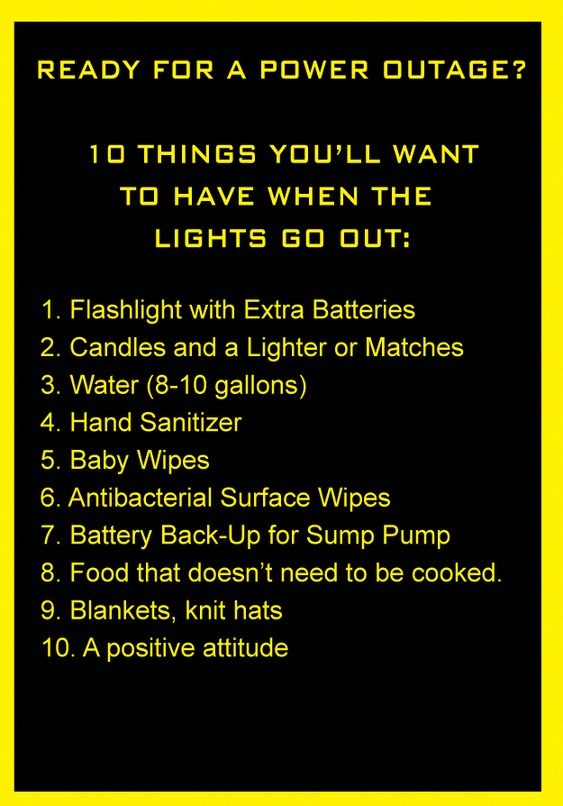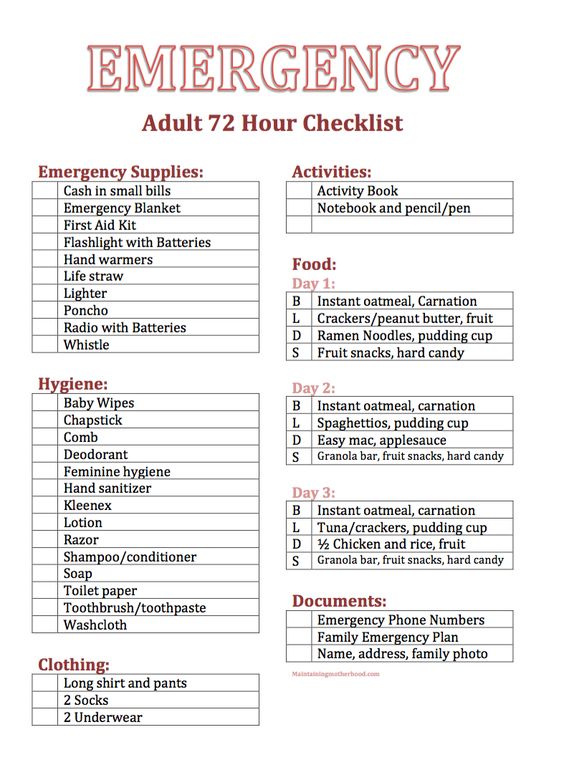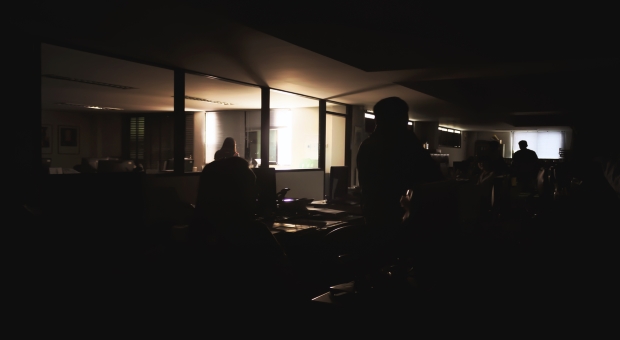If you haven’t heard, California is experiencing a series of intentional power outages, as the electric company shuts down power in multiple counties in order to avoid disaster.
Thousands of people are losing electric power and all that goes with it in an effort to prevent a repeat of last year’s Camp Wildfire.
Rather than a temporary situation, this is looking more and more like it will continue for the foreseeable future, as a new series of programmed power outages have just been announced. High winds are causing power company officials to make these decisions, over concerns that their infrastructure can’t handle the high winds without the risk of severe damage, leading to fires.
Many have said, at one time or another, that California foretells what is going to happen in the rest of the country. Whether we’re talking about political action, societal change or financial trends, it happens in California first, then spreads to the rest of the country. Whether this is true or not, it appears that it might be so in this case.
Our Aging Infrastructure
One of the realities we must face up to is that our country’s infrastructure is growing old. From bridges to power plants, there are more and more parts of the infrastructure which have surpassed their programmed life expectancy of 50 years. Yet in most cases, the money just isn’t there to replace that infrastructure, necessitating a constant string of ongoing repairs, just to keep the systems going.
For example, the harbor bay bridge in Corpus Christi, Texas was built in 1956 for a cost of $2.2 million. Based upon that construction date and a programmed life expectancy of 50 years, the end of its useful life was supposed to come in 2006, yet it is just now in the process of being replaced, at a cost of $802 million. Yet there are many other bridges and infrastructure projects in our country which are even older and probably in even greater need of replacement.
Part of what has spurred action in this particular project is that the port of Corpus Christi is the number one petroleum port in the United States. Not only is the bridge replacement going to solve a number of safety issues, but together with dredging the shipping channel to make it deeper, is going to allow larger ships to dock at the port, increasing shipments of petroleum.
But not all infrastructure projects have that great a potential financial incentive. In many cases, it is difficult to make a case based upon financial advantage alone. Yet that doesn’t mean that those projects don’t need to be done. It just means that the money usually goes to the projects with the greatest potential gain.
This is a problem plaguing all of our infrastructure. Much of it was built during the heyday of our nation’s financial growth, following World War II. Massive government projects were built all across our country, in an effort to spur the economy. They did that, as well as giving us the infrastructure we currently have.
Yet according to the American Society of Civil Engineers (ASCE) 2017 Report Card, the current level of our infrastructure is only at a D+.[1] This report, which comes out every four years, is the most accurate, non-partisan rating of the various parts of our country’s infrastructure, including our electric power grid.
Click here to find out how to survive when the lights go out!
In fact, bridges are much better off than our energy grid, with a rating of C+. That means it’s considered to be just above mediocre and requires attention to be ready to meet the challenges of the future. By comparison, energy is at D+, which means, according to the ASCE Infrastructure Report Card website:
“The infrastructure is in poor to fair condition and mostly below standard, with many elements approaching the end of their service life. A large portion of the system exhibits significant deterioration. Condition and capacity are of serious concern with strong risk of failure.[2]
The main reason why the infrastructure report card gives energy a rating of D+ is due to the age of the system. Our electric grids (there are three of them) were mostly built in the 1950s and 1960s, when electrical power usage growth was at its highest. At the time, available knowledge about the design of those systems limited their life expectancy to 50 years. Yet today, the average age of those plants is 39 years old. Amongst coal-fired plants, still the most common, the average age is fast approaching their life expectancy.
On the other hand, the average age of natural gas power plants is only 22 years, which is promising, as natural gas, not solar and wind power, are what is taking over the burden of providing us with electric power. While renewable may ultimately be our country’s energy future, the technology just isn’t there yet to do it.
Replacing the Grid
 But it isn’t the power plants that are the biggest concern, although they get the most attention. Rather, it is the age of the vast network of power transmission lines and substation transformers which are the bigger concern. Seventy percent of this grid is over 25 years old and there are parts of it that were built in the late 1800s, when electric power was first being brought to the country.
But it isn’t the power plants that are the biggest concern, although they get the most attention. Rather, it is the age of the vast network of power transmission lines and substation transformers which are the bigger concern. Seventy percent of this grid is over 25 years old and there are parts of it that were built in the late 1800s, when electric power was first being brought to the country.
Replacing this electric grid could cost as much as $5 trillion dollars, more than a fourth of the US GNP. Compared to the initial cost of building the grid we are now dependent on, this would entail a huge investment, more than anyone can see a way to pay for.
Part of the problem is that the grid was built with corporate money; companies which invested in building the grid in order to sell electric power to customers. Essentially, they were investing in their future earnings and paid for that investment over a number of years.
In the early days, adding to the grid was fairly easy, as most electric generation and use was local. Costs were minimal, by comparison, as there was minimal regulation. In an effort to make a profit, electric companies built their power transmission lines and sent their product to areas of high customer density, thereby spreading the cost over a wide base and helping pay for it.
As the system grew, demand grew as well, allowing these same companies to grow and pay for their new additions. They spread out into areas of lower customer density, knowing that the increased usage of electricity would pay for those additions. These utility companies were basically able to fund their growth and survive, due to the growth of electricity usage in a myriad of different ways.
Today there is still growth, but it is a slow growth, compared to the years when those companies had their great growth spurts. While we are constantly finding new ways of using electricity, we are also finding ways of using it more efficiently. So there is actually a negative growth of electricity consumption per capita, with the only actual growth coming from population growth.
What this all means is that the companies which originally built the electric grid don’t have the money to rebuild it and bring it up to date. Some other scheme is going to have to be created, in order to find a way to make the necessary investment in our electrical grid and the rest of the infrastructure or we can expect it to continue to decline.
What Does that Have to do with California?
With our electrical grid being so far outdated, one of the concerns is that it is running at or sometimes over capacity. While electrical wires can carry a higher current than normally specified, that cuts into the safety margin built into those specifications. Ultimately, it affects the life expectancy of that equipment.
In the case of electrical wires, running current through them generates heat. The more power run through them, the more heat generated. You’ve probably felt that at some time, grabbing the power cord to something and finding that it was hot.
Now imagine if you were running something that uses a lot of electricity, like a window air conditioning unit, through a cheap extension cord, the kind you buy at the dollar store for $1.99. Those extension cords have smaller diameter or gauge wire in them than the cord for the AC unit. Forcing that much electric power through that cheap extension cord will cause it to heat up, possibly to the point of melting the insulation and burning the cord out.
The same principle applies to high tension power lines, although there is no insulation and the wires are intended to carry much more power over much greater distances. When the system is running at 100% of its rated power, those wires are rather warm; but when it is running over that 100%, they can get downright hot.
We don’t see them as hot, as the wires are insulated by air, not plastic that can melt. At the power poles the wires are connected to ceramic insulators, which can withstand much more heat than the wires can produce. But if the wires get hot enough, they will begin to sag, following the principle that materials (especially metals) expand when they are heated. As they expand, the wires sag a measurable amount between the poles.
Combine those sagging wires with high winds and you have a potential problem. The wires are not going to sway in the wind evenly, especially in a gusting wind. Eventually, the swaying can cause those wires to make contact, creating a great shower of sparks. In dry conditions, that can lead to fire.
That’s the sort of thing that power company officials are concerned about in California. Apparently they’ve had a number of fires, which have been caused by similar sorts of circumstances. In the worst of those, wires were broken by the wind or by arcing when they touched. The danger from such occurrences is so great, that they feel justified in shutting down people’s power, just to avoid another wildfire being started in that manner.
It’s Not Just California
 While we can all point our fingers at California and laugh about how they are confronted by this problem; in reality, none of us are very far from it. According to an article from “Inside Energy,” the rate of major power outages is on the rise across the country.[3]
While we can all point our fingers at California and laugh about how they are confronted by this problem; in reality, none of us are very far from it. According to an article from “Inside Energy,” the rate of major power outages is on the rise across the country.[3]
The data on major power outages is compiled in blocks of five years. Looking at this data, we can see that the annual average number of power outages has been doubling every five years.
- 2000 – 2004 – Average of 44 power outages per year
- 2005 – 2009 – Average of 100 power outages per year
- 2010 – 2013 (only four years) – Average of 200 power outages per year
You can be sure that power company officials across the country, as well as concerned government workers, are closely watching what is going on in California right now. If their efforts to avoid disaster prove effective, chances are pretty high that such mandated blackouts are going to become a common defense against the fire risk associated with a combination of poor weather and overloaded power lines.
Considering that the highest electric usage is during the summer months, when people are running their air conditioners full-time, the most likely time to see those programmed power outages is going to be when we need our electricity the most, in order to combat summer’s heat.
The Off-Grid Solution
Californians who have invested in “off-grid” solar power are finding that their investment hasn’t helped them at all during these officially mandated outages. Most of those systems were installed by solar power contractors who were not interested in protecting the homeowners against power outages, but rather in selling their products. So the systems are connected to the power meter, without a whole house switch and there is no battery backup system.
What that means is that the solar power systems these people spent a small fortune on is feeding the grid, not their homes. The promise is that when they have excess power it will go into the grid and when they need more power they’ll draw it form the grid. That’s true. But when there is no power in the grid, their solar power system sends whatever it produces into the grid, not into their homes.
Few of those systems are more than a grid of solar panels, installed to match the roof’s pitch. The installers don’t even bother to try and install them in a way to gain the most efficiency from the panels, let alone providing emergency electrical power in a blackout.
Even installing a battery backup system, like the Tesla Powerwall, isn’t enough. While the Powerwall stores 13.5 kWh of power, enough for several days of normal operations, for an average home, the same problem exists. Without a switch to disconnect the home from the grid, all the power in that or any other battery backup system is going to go into the grid, leaving your home without any electrical power.
The key is the combination of the battery backup system and a whole house switch. Those switches can be expensive, especially if you use the automatic type that is designed to go with a whole house generator. But there are also manual versions available.
Another option is to keep your off-grid power system totally disconnected from the grid, powering some things in your home off the grid and others off of your off-grid system. While considerably more complicated, this does give you the advantage of being able to have your system running at all times, without the risk of losing all your stored energy to the grid, in the case of a blackout.
Conclusion
Regardless of what you decide to do, we must realize that blackouts are going to become more common, not less common. Until a solution for our aging grid is found, we can expect the rate of blackouts to continue; and if power company officials adopt programmed outages as a means of combating potential problems with aging equipment, we won’t be able to count on electrical power for much of anything.
Resources
[1] https://www.infrastructurereportcard.org/americas-grades/
[2] https://www.infrastructurereportcard.org/making-the-grade/what-makes-a-grade/
[3] http://insideenergy.org/2014/08/18/power-outages-on-the-rise-across-the-u-s/












































































It’s pretty pathetic when the government pressures you to buy electric cars and then shuts off the power. Self-reliance, resourcefulness, a healthy skepticism of the government and networking with other like-minded people is the way to go.
I need a reliable electricity provider. Now that this public utility company can no longer provide that I will be taking my business elsewhere and perhaps cancel their service like anyone else who cant perform .
Isnt it amazing how “they” question the economic feasibility of things like seawater desalination plants and improvements to the grid but all our foreign wars and aid to illegals get a blank check.
To answer the question that the title of the article presents:
Yes, they are. And they will get worse up until the point of total failure of the system, and then the rest of the US infrastructure.
Just my opinion.
I’m 65, I was raised in the mountains of Washington State. We experienced Wind, Rain, Snow and even Wild Fire Storms. Mudslides and lower area level flooding. The things we prep for today were a way of life for us in the 1960’s and 1970’s. Blackouts could last a week or more. No Phones, none of the three TV networks for real, unbiased news. Few close neighbors meant Isolation for days. But we did check up and take care of each other. We planned for these emergencies, and more. And we survived. The only people that panicked were the unprepared.. I’m getting ready to move back up there. Its a much simpler and quieter world. I’ll survive.
Commiefornia’s electrical power problems stem from the socialists in Sacramento suing the power companies and blaming them for the states mismanagement . They have made it to where the companies shut off power to save themselves from frivolous lawsuits. Wish the power companies there would just say that business in cal. is not profitable and shut down and pull poles, roll up wire and move to another state. Maybe this would save their “planet”.
They are slowly easing us into living without power. Unless we can overthrow world governments we need to learn to live like the Amish!
Possible Solution To Help The Power Grid Problem
I have traveled around the world seveal times and flew over many countries. All these countries have one thing in common…. Roof Tops. It has occurred to me that the fat cats could install solar panels on these roofs with the Tesa Powerwall with automatic disconnect switch from the grid. This would give the average home power for several days. A secondary disconnect switch could be installed to allow the homeowner to completely disconnect from the grid. The electrical company could also install a secondary meter to monitor the power being used when not connected to the grid. The homeowner should also be allowed to pay a small sum each month towards owning the system completey and allowed to disconnect from the grid without being charged any further for electrical usage. This should help in rebuilding the power grid and reduce the demand on it during peak hours. I forsee new building codes that require every new home and city buildings be equiped with this type of system.
I heard from someone who claims to be an eyewitness that a large part of the problem is that the power company has been forbidden to prune the foliage that touches the power equipment (lines, poles, and transformers) by the government on ecological grounds. The power company employees are also being shot at while they are trying to do their jobs. Strange that there is no word of this in the mainstream media…
Who is making this claim and how is their info backed up? I own hundreds of acres of orchard along a highway with a power poles along it on the edge. The power company trims it almost yearly. All my orchard growing farmer friend’s have the same experience, no problems with power company or “ecological grounds” as you state, and I’m in California
Power workers are being shot at! Where? When? And who reported this to you? Please back some of this up somehow….
Excellent article but you mention 200 power outages per year? I’m sure we have that many in my immediate area, Allentown, Pa